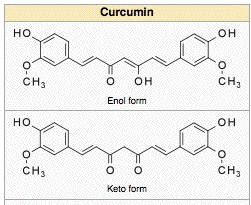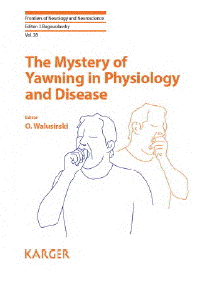- Popular
South Asian spice turmeric and
Yawning
-
- Curcumin
(pronounced "Kur kyoo min") is a
diarylheptanoid. It is the principal
curcuminoid of the popular South Asian spice
turmeric, which is a member of the ginger family
(Zingiberaceae). Turmeric's other two
curcuminoids are desmethoxycurcumin and
bis-desmethoxycurcumin. The curcuminoids are
natural phenols that are responsible for the
yellow color of turmeric.
-
- Curcumin is a major constituent of turmeric
and influences many functions of the brain. In
the present study, the authors investigated the
effect of curcumin on yawning induced by
apomorphine in rats.
-
- Curcumin administered orally for 10
consecutive days. Yawning was induced by
subcutaneous (s.c.) injection of apomorphine (a
dopamine receptor agonist) and the number of
yawns was recorded for a period of 30 min.
-
- Apomorphine (0.05 and 0.1 mg/kg) produced
yawning. Haloperidol (a dopamine receptors
antagonist) at a dose of 0.05 mg/kg partially
and at a dose of 0.2 mg/kg completely inhibited
apomorphine-induced yawning. Curcumin alone
produced no yawning, whereas at doses of 30 and
60 mg/kg, it increased yawning induced by 0.1
mg/kg of apomorphine. Curcumin at the high doses
(30 and 60 mg/kg) produced yawning when
apomorphine (0.1 mg/kg) action was partially
blocked with 0.5 mg/kg of haloperidol. In the
presence of complete blockade of apomorphine
(0.1 mg/kg) action with 0.2 mg/kg of
haloperidol, curcumin did not produce
yawning.
-
- The results showed that curcumin at high
doses increased apomorphine-induced yawning. In
the presence of partial, but not complete
blockade of apomorphine action, curcumin
produced yawning. Curcumin produced a
dopamine-like effect on yawning.
-
 -
- Safran
des Indes et
bâillements
-
- La
curcumine ou diféruloylméthane est
le pigment principal du curcuma (Curcuma
longa), aussi appelé safran des
Indes. C'est un pigment polyphénolique
(curcumoïde) qui donne une couleur
jaune.
-
- La curcumine est le constituant actif
principal du curcuma et influence
l'activité cérébrale. Dans
la présente étude, les auteurs ont
étudié l'effet de la curcumine sur
le bâillement induit par l'apomorphine
chez le rat.
-
- La curcumine a été
administrée par voie orale pendant 10
jours consécutifs. Le bâillement a
été induit par injection
d'apomorphine (un agoniste du récepteur
de la dopamine), par voie sous-cutanée
(sc) et le nombre de bâillements
été enregistrés pendant une
période de 30 min.
-
- L'apomorphine (0,05 et 0,1 mg / kg)
déclenche des bâillements.
L'halopéridol (un antagoniste des
récepteurs de la dopamine), à une
dose de 0,05 mg/kg inhibe partiellement et
à une dose de 0,2 mg / kg inhibe
complètement les bâillements
induits par l'apomorphine. La curcumine seul ne
produit aucun bâillement, alors que des
doses de 30 et 60 mg/kg, a augmenté le
nombre de bâillements induits par 0,1
mg/kg d'apomorphine. La curcumine à des
doses élevées (30 et 60 mg/kg) a
produit des bâillements alors que l'action
de l'apomorphine (0,1 mg/kg) était
partiellement bloquée avec 0,5 mg/kg
d'halopéridol. En présence du
blocage complet de l'effet de l'apomorphine (0,1
mg/kg) avec 0,2 mg/kg d'halopéridol, la
curcumine n'a pas produit de
bâillement.
-
- Ces résultats montrent que la
curcumine à des doses
élevées augmente le nombre de
bâillements induits par l'apomorphine. En
présence d'une dose réduite, mais
l'action de l'apomorphine le blocage n'est pas
complet et pourtant la curcumine provoque des
bâillements. La curcumine a un effet
dopamine-like pour délclencher des
bâillements.
- Introduction
-
- Yawning is a common stereotyped behavior
that occurs in most vertebrates and humans
(Baenninger and Greco, 1991). In mammals, it
consists of an involuntary sequence of mouth
opening, deep inspiration, brief apnea, and slow
expiration (Baenninger, 1997). Yawning is under
a coordinated control of several
neurotransmitters and neuropeptides such as
histamine, acetylcholine, excitatory amino
acids, y aminobutyric acid (GABA), oxytocin, and
opioid peptides in the central nervous system
(Tamaddonfard et al., 2008a; Collins and
Equibar, 2010). Several lines of pharmacological
evidence suggest that dopamine is involved in
the yawning expression (Melis et al., 1987;
Zarrindast and Jamshidzadeh, 1992; Collins et
al., 2005; Li et al., 2010).
-
- Curcumin is the active ingredient in the
traditional herbal remedy and dietary spice
turmeric and has a surprisingly wide range of
beneficial properties, including
antiinflammatory, analgesic, antiepileptic,
antioxidant, chemopreventive, and
chemotherapeutic activities (Hatcher et al.,
2008; Tamaddonfard et al., 2009, 2010, 2012).
Curcumin influences brain neurotransmission,
function, and behavior (Kulkarni et al., 2008;
Wang et al., 2008; Bhutani et al., 2009). Some
evidences suggest protective roles for curcumin
in brain pathology. Oral administration of
curcumin has resulted in the inhibition of
amyloid l
-
- deposition and oligomerization, and tau
phosphorylation in the brains of Alzheimer
disease animal models, and improvements in
behavioral impairment in animal models
(Hamaguchi et al., 2010). In intracerebral
hemorrhage model in mice, curcumin prompted
hematoma resolution and limited neurological
injury (King et al., 2011).
-
- In the present study, we investigated the
effects of oral administrations of curcumin on
yawning induced by apomorphine. In the
-
- presence of partial and complete blockades
of apomorphine action with low and high doses of
haloperidol, the effects of curcumin on yawning
were also investigated.
-
- Discussion
-
- In the present study, apomorphine produced
yawning and haloperidol inhibited
apomorphine-induced yawning. This confirms the
dopaminergic system involvement in yawning
phenomena. The involvement of dopamine in
yawning was first suggested by the discovery
that dopamine receptor agonists such as
apomorphine, bromocriptine, and lisuride were
able to induce yawning in rats (Baggio and
Ferrari, 1983; Melis et al., 1987; Ushijima et
al., 1988). Using dopamine agonists such as
apomorphine, bromocriptine, pramipexole,
quinelorane, and quinpirol, and dopamine
antagonists including L-721 626, U991194, and
nafadotride, the involvement of dopaminergic
system in yawning was firmly confirmed (Collins
et al., 2005, 2007). Haloperidol, a nonselective
dopaminergic antagonist with high affinity for
all dopamine receptor subtypes (Sokoloff et al.,
1992), inhibited PD-128907-, quinelorane-, and
apomorphine-induced yawning in rats (Collins et
al., 2005, 2007).
-
- In the present study, we used oral
administration of a normal saline suspension of
curcumin. Curcumin is insoluble in water, but is
soluble in ethanol, alkalis, ketone, acetic
acid, and chloroform (Araujo and Leon, 2001).
Oral administrations of a normal saline
suspension of curcumin have been frequently used
to survey its biological and pharmacological
properties (Tamaddonfard et al., 2008b, 2009;
Buadonpri et al., 2009). We observed curcumin
responses with high (30 and 60 mg/kg), but not
low and medium (3.75, 6.5, and 15 mg/kg) doses.
This result is in agreement with other findings
in which responses to high doses of curcumin
were studied (Tamaddonfard et al., 2008, 2009;
Buadonpri et al., 2009). This effect of curcumin
may partly be due to its low systemic bioavai
lability following oral
-
- administration due to efficient first-pass
metabolism and some degrees of intestinal
metabolism (Sharma et al., 2007). Although
curcumin has low systemic bioavailability after
oral administration, the achievement of
efficacious concentrations in the
gastrointestinal tract is sufficient for
exerting beneficial effects in animals and
humans (Sharmaet al., 2005).
-
- In the present study, curcumin increased
apomorphine-induced yawning. In addition, in the
presence of partial blockade of apomorphine
action with haloperidol, curcumin produced
yawning. Moreover, when apomorphine effect was
completely blocked with haloperidol, curcumin
did not produce yawning. These indicate that
curcumin contributes to dopaminergic system in
producing yawning. Curcumin exhibits
antioxidant, anti-inflammatory, and anticancer
properties, crosses the blood-brain barrier and
is neuroprotective in neurological disorders
such as Parkinson [I s disease (Mythri and
Bharat, 2012). Curcumin potentially affects
dopaminergic neuron function and health in the
brain. Acute administration of curcumin at high
(40 and 80 mg/kg), but not at low (10 and 20
mg/kg) doses, increased dopamine levels in the
brain (Kulkarni et al., 2008).
-
- Curcumin pretreatment mitigated
lipopolysaccharide-induced dopaminergic neuron
degeneration and curcumin posttreatment showed
protective effects (Yang et al., 2008).
Long-term (21 days) administration of
haloperidol increased vacuous chewing movements
and facial jerkings and decreased turnover of
dopamine in cortical and subcortical regions of
the brain. Chronic pretreatment with curcumin
reversed all changes induced by haloperidol
(Bishoni et al., 2008). In addition, chronic
oral administration of curcuminoids including
curcumin, demethoxycurcumin, and
bisdemethoxycurcumin prevented striatal
dopaminergic neurodegeneration induced by
6-hydroxydopamine model of Parkinsonism in rats
(Agrawal et al., 2012). Curcumin, through its
iron-chelating property, produced protective
effects on 6-hydroxydopamineinduced degeneration
of nigral dopaminergic neurons (Du et al.,
2012). Moreover, curcumin supplementation
reduced alternation of dopamine D1 and D2
receptors in cerebral cortex and cerebellum of
diabetic rats (Kumar et al., 2010). It seems
that curcumin can affect brain neurotransmitter
function through multiple pathways including
gene expression, receptor protection, and
neurotransmitter level changing.
-
- In conclusion, the results of the present
study indicated that apomorphine by activating
endogenous dopamine produced yawning, and
haloperidol, a dopaminergic antagonist, blocked
apomorphine-induced yawning. Curcumin increased
the yawning induced by apomorphine. In the
presence of partial, but not complete blockade
of apomorphine action with haloperidol, curcumin
produced yawning. Curcumin, at least, in the
present study exerted a dopamine-like
activity.
-
-
-
|



